The world has caught on to the craze of pumping iron and sculpting muscles, and it’s no surprise given the great physical and mental perks that come along with it. When it comes to the workout routine, spotlighting your chest and triceps can do wonders, not just for the mirror appeal, but for boosting your body’s overall power and functionality too.
Think of your chest muscles as your body’s personal pushing powerhouse, while your triceps – those hard workers tucked away at the back of your upper arm – help out with all your push and pull needs.
Building up these muscles can open a world of benefits. Got a set of shoulder presses or push-ups on your gym schedule? A well-built chest and triceps combo will see you powering through those with ease. And it doesn’t stop at the gym door – everyday tasks like lifting hefty objects become a breeze. More so, the muscle-building process revs up your metabolism, helps you stand a little taller with better posture, and guards you against injuries. On the flip side, a chiseled chest and defined triceps can add to your body’s symmetry, leading to a confidence-boosting sculpted look.
But before you dive headfirst into strength training, take note of a few things. Warm-up is your non-negotiable starting point, readying your muscles and joints for the job at hand. Next, keep a watchful eye on your form throughout the workout, that’s your injury-prevention insurance. Tune into your body’s signals and adjust exercises accordingly, especially if you’re a newbie or nursing any old injuries or conditions. Finally, don’t forget the golden rule of muscle building – consistency. Challenge yourself but keep the routine something you can stick with. After all, this muscle-building journey is more of a marathon than a sprint!
Understanding the Anatomy
Overview of the chest muscle groups (pectoralis major and minor)
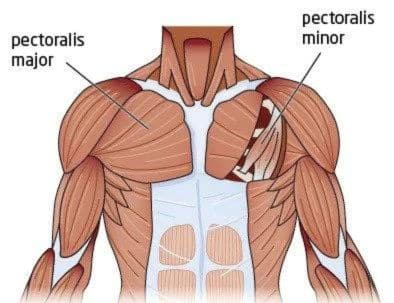
The chest is primarily composed of two muscle groups, the pectoralis major and pectoralis minor. The pectoralis major, often known as “pecs,” is the larger, more visible muscle that gives the chest its shape. It originates from the clavicle (collarbone) and sternum (breastbone) and inserts into the upper arm (humerus). Its main functions include bringing the arm across the body (adduction), rotating the arm inward (internal rotation), and pulling the arm down from a raised position (depression).
Underneath the pectoralis major lies the smaller pectoralis minor. It’s a thin, triangular muscle, which originates from the third to fifth ribs and inserts into the coracoid process of the scapula (shoulder blade). It helps in movements like drawing the shoulder forward and downward.
Overview of the triceps muscle group (triceps brachii)
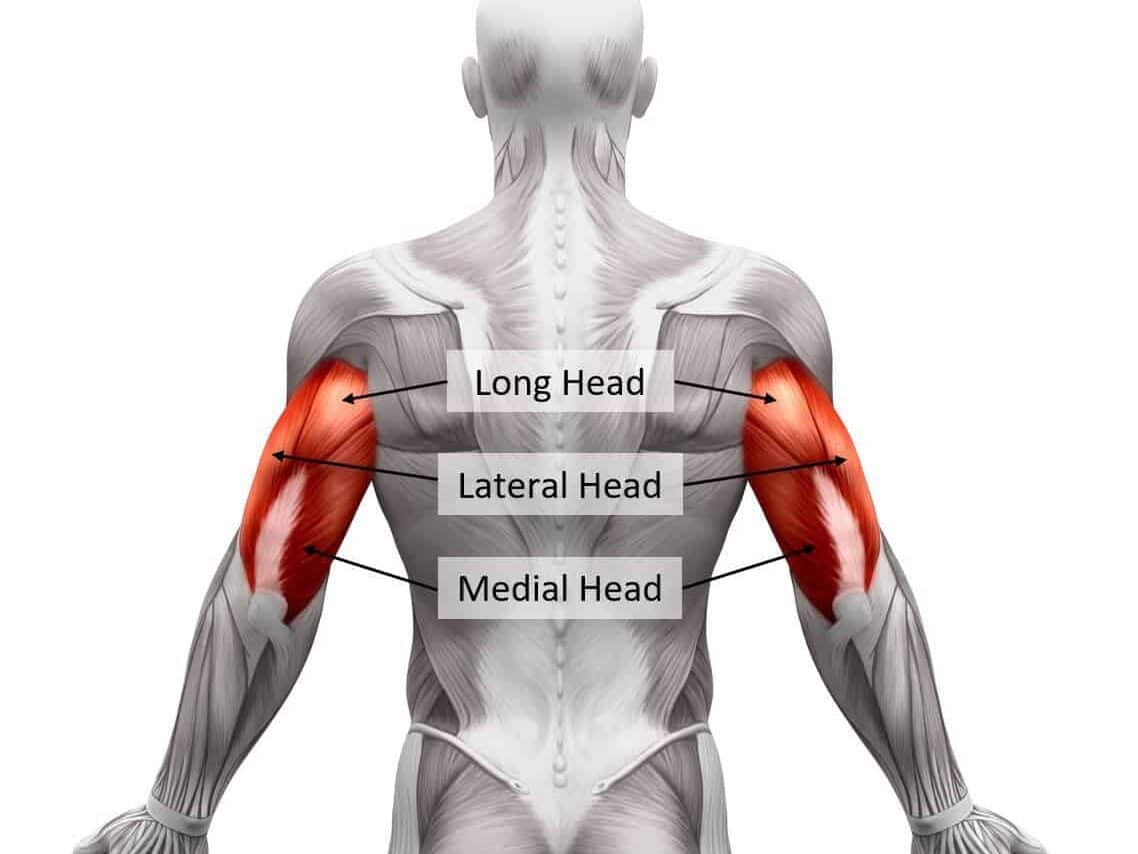
The triceps brachii, commonly known as the triceps, is a large muscle on the back of the upper arm. It is composed of three heads – the long, lateral, and medial head, each originating from different parts of the upper arm and shoulder and converging to insert at the elbow via the triceps tendon. As the name suggests (“tri” meaning three), the triceps brachii is a three-part muscle. The primary function of the triceps is to extend the elbow, straightening the arm.
Relationship between chest and triceps in upper body movements
Chest and triceps muscles work together in various upper body movements. In most pushing actions, like push-ups, bench press, or even simply pushing a door open, the chest and triceps activate concurrently. The chest muscles primarily initiate the pushing movement, and the triceps help extend the arm to complete it. By training these muscles together, you can achieve more balanced strength and muscular development.
Nutrition and Recovery
Importance of nutrition in muscle growth and recovery
Alongside regular exercise, nutrition plays a significant role in muscle growth and recovery. When you work out, especially during strength training, the muscle fibers endure tiny micro-tears. The body repairs these micro-tears during rest, resulting in muscle growth. However, for this process to happen efficiently, the body needs adequate nutrients as building blocks. Proper nutrition ensures your body gets the necessary fuel for your workouts and resources for muscle repair and growth post-workout.
Key nutrients and foods beneficial for muscle building
Protein is the most important nutrient for muscle building. The body uses amino acids (protein) to repair and build muscle fibers. Sources of high-quality protein include lean meats, poultry, fish, eggs, dairy, tofu, and legumes.
Carbohydrates are equally important as they provide the energy needed for intense workouts. Opt for complex carbohydrates like whole grains, fruits, and vegetables, which provide sustained energy.
Healthy fats, particularly omega-3 fatty acids, aid in muscle recovery and inflammation reduction. Avocados, nuts, seeds, and fatty fish like salmon are excellent sources.
Don’t forget vitamins and minerals, which are crucial for various bodily functions. They assist in energy production and muscle recovery. Leafy greens, fruits, nuts, seeds, and lean proteins can provide a wide range of these nutrients.
Importance of rest and recovery in muscle growth
Rest and recovery are as critical to muscle building as the actual workout. During rest, your body repairs the micro-tears in the muscle fibers, leading to muscle growth. Furthermore, adequate sleep boosts the production of growth hormone, a key player in muscle development. Aim for 7-9 hours of sleep per night, and allow at least 48 hours of recovery between intense workouts targeting the same muscle group. Implementing active recovery techniques, like light cardio or yoga, can also enhance blood flow and accelerate the recovery process.
Best Exercises for Chest
Bench press variations (flat, incline, decline, dumbbell)
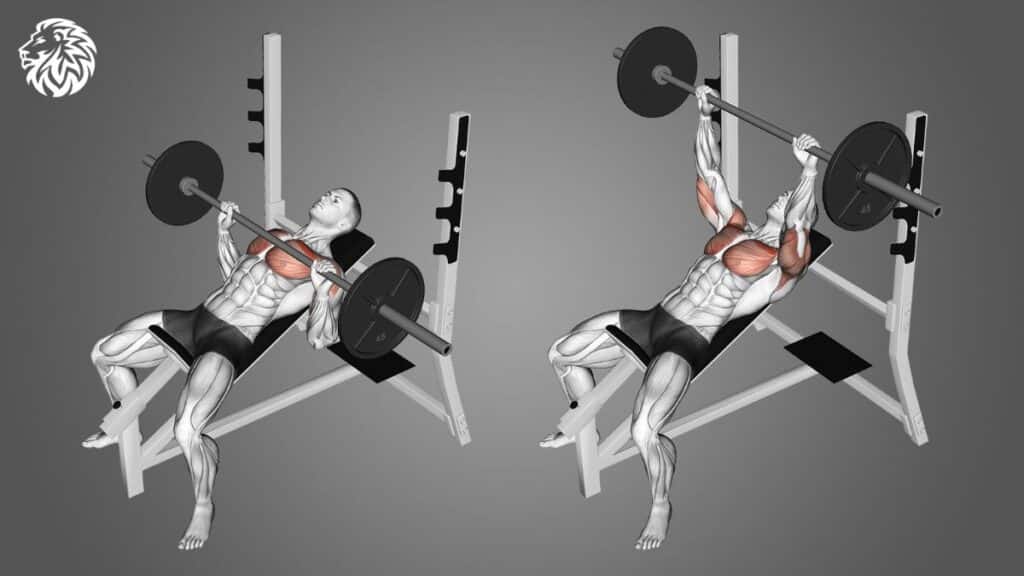
The bench press and its variations are classic exercises for chest development. The flat bench press targets the entire pectoralis major, while the incline and decline variations focus on the upper and lower pecs, respectively. Dumbbell bench presses are also effective and allow for a greater range of motion.
Proper form: Lay on the bench with your feet firmly planted on the floor. Hold the barbell or dumbbells at shoulder width. Lower the weights to your mid-chest, then press them back up until your arms are fully extended.
Reps and sets: Aim for 3-4 sets of 8-12 repetitions.
Safety tips: Always use a spotter when lifting heavy weights. Keep your back flat against the bench and avoid lifting your hips off the bench during the press.
Chest fly variations (cable, dumbbell)
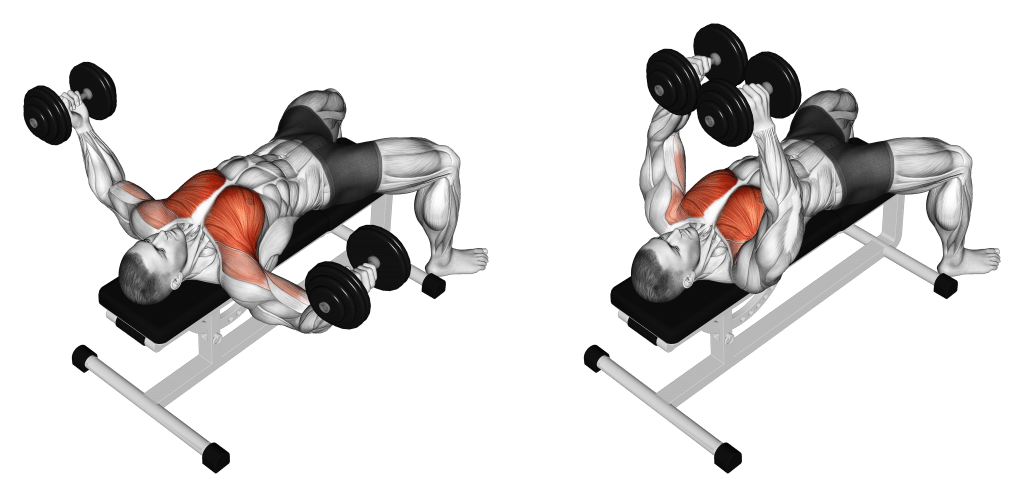
Chest fly exercises isolate the chest muscles, providing a different stimulus compared to the compound movement of a bench press.
Proper form: For dumbbell flies, lay on a flat or incline bench, holding a dumbbell in each hand with arms extended above you. With a slight bend in the elbows, lower the weights out to the sides in an arc motion until you feel a stretch in your chest. Then bring the weights back up to the starting position.
For cable flies, adjust the pulleys to chest height, grab the handles and step forward slightly. With a slight bend in your elbows, bring your hands together in front of your chest, then slowly reverse the movement.
Reps and sets: Aim for 3-4 sets of 10-15 repetitions.
Safety tips: Avoid using heavy weights that could strain your shoulder joints. Always maintain a slight bend in your elbows to prevent injury.
Push-ups and its variations
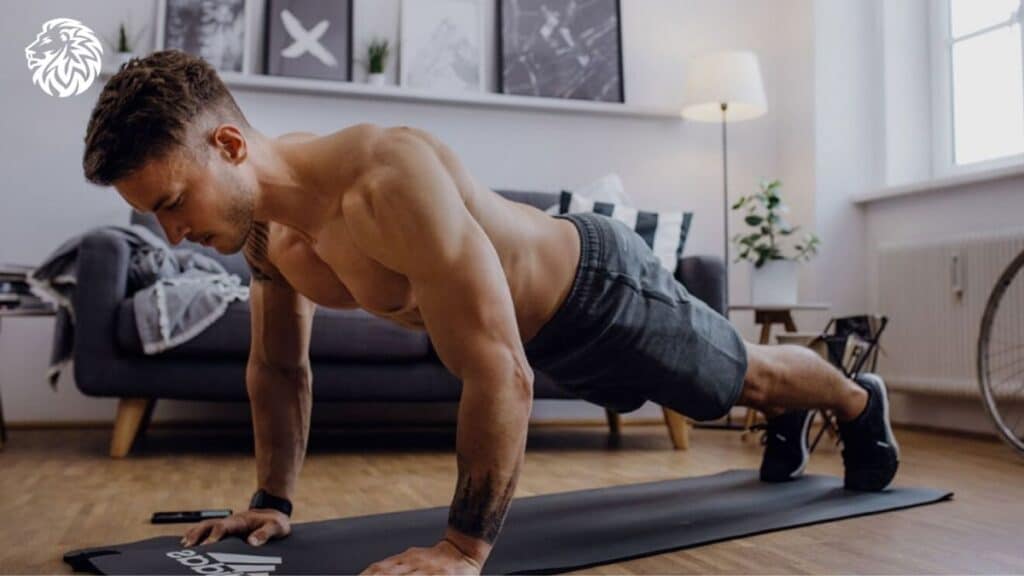
Push-ups are a versatile bodyweight exercise that can be done anywhere. Variations like decline, incline, or diamond push-ups can target different areas of the chest.
Proper form: Begin in a high plank position with hands slightly wider than shoulder-width apart. Lower your body until your chest nearly touches the floor, keeping your body straight. Push back up to the starting position.
Reps and sets: Aim for 3 sets of as many reps as you can perform with good form.
Safety tips: Keep your core engaged to prevent your hips from sagging or rising too high. Ensure your neck is in line with your spine and your gaze is slightly ahead of you.
Proper form, reps, sets, and safety tips for each exercise
The key to effective strength training is maintaining proper form throughout each exercise to maximize muscle engagement and prevent injury. Always control the weights, moving them in a slow, steady manner. For muscle growth, aim for higher volume (more sets and reps) with moderate weight. If you’re new to strength training, consider working with a fitness professional to learn correct form and technique. Lastly, always listen to your body and stop any exercise that causes pain beyond typical muscle fatigue.
Best Exercises for Triceps
Dips and its variations
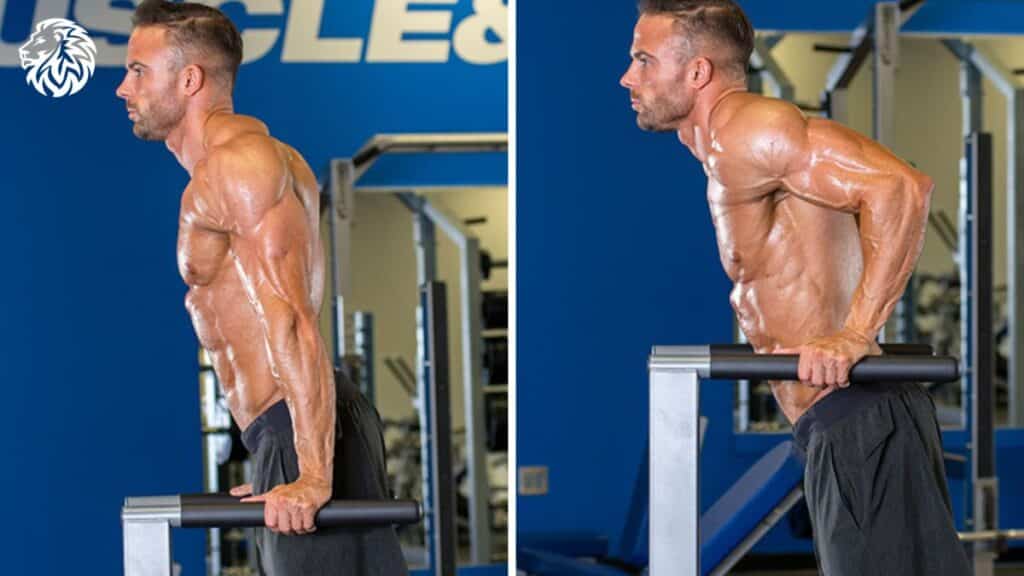
Dips are a powerful bodyweight exercise that targets the triceps. You can perform them on parallel bars, a bench, or even a chair.
Proper form: Hold onto the bars (or edge of a bench or chair), with your arms straight and feet suspended off the floor. Lower your body by bending your elbows until they’re at about a 90-degree angle, then push yourself back up to the starting position.
Reps and sets: Aim for 3 sets of as many reps as you can perform with good form.
Safety tips: Ensure your elbows are pointing back, not flaring out. Avoid going too low, as it could strain your shoulder joints.
Triceps pushdowns (cable)
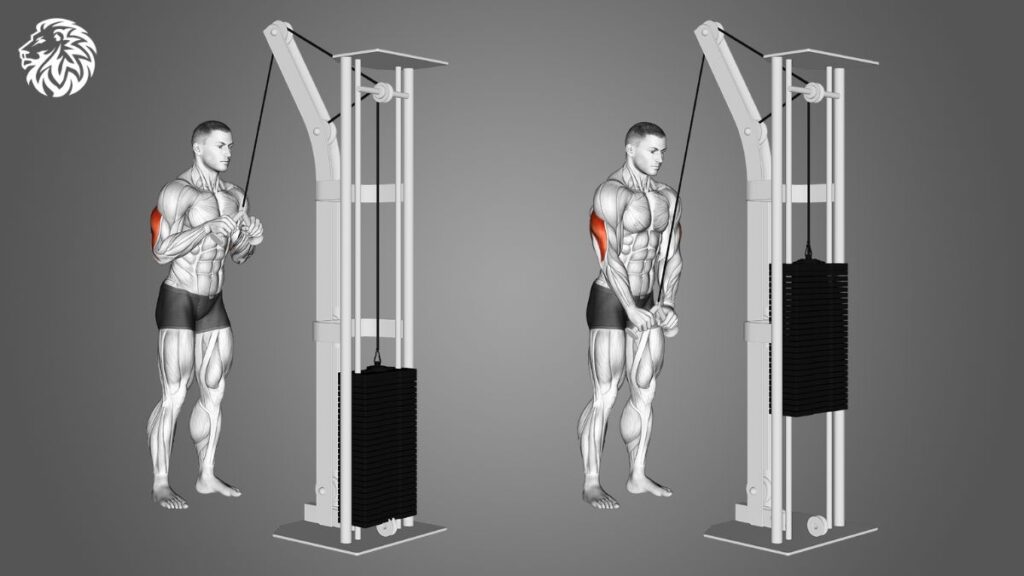
Triceps pushdowns are a popular and effective isolation exercise for the triceps.
Proper form: Stand in front of a cable machine, holding the bar with an overhand grip and elbows tucked at your sides. Push the bar down by extending your elbows until your arms are straight. Slowly return to the starting position.
Reps and sets: Aim for 3-4 sets of 10-15 repetitions.
Safety tips: Keep your elbows close to your body and avoid using your back or shoulders to push the bar down.
Overhead triceps extensions (dumbbell, cable)
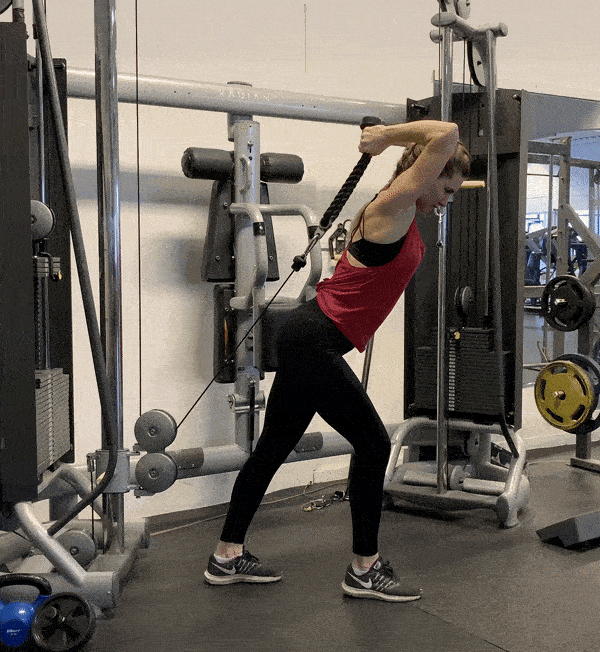
Overhead extensions stretch the long head of the triceps, promoting balanced muscle development.
Proper form: Stand or sit with a dumbbell held with both hands or a cable handle overhead. Keeping your elbows close to your head, lower the weight behind your head by bending your elbows. Extend your arms to lift the weight back up.
Reps and sets: Aim for 3-4 sets of 10-15 repetitions.
Safety tips: Keep your elbows stationary and avoid using your shoulders to lift the weight.
Close-grip bench press
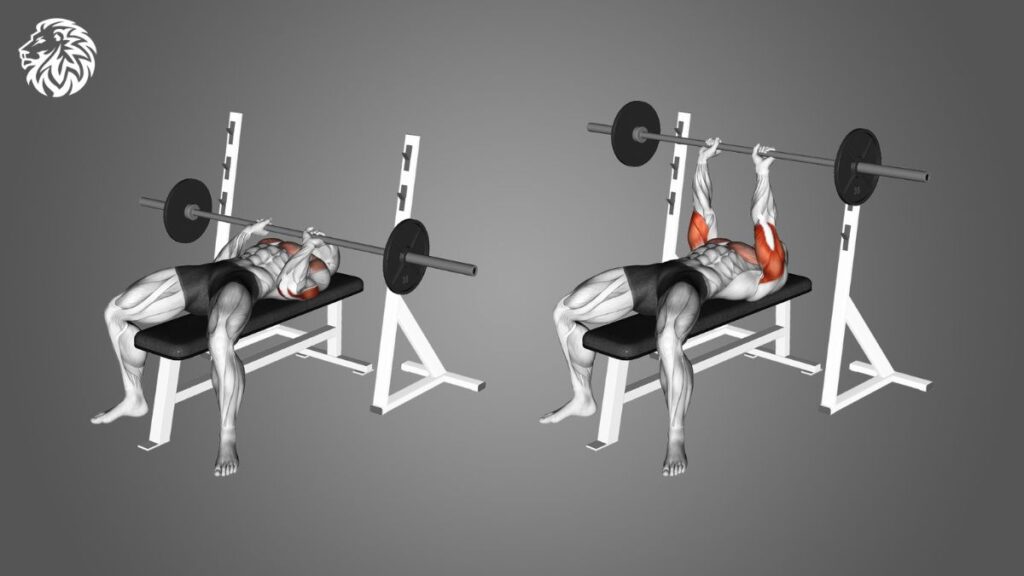
The close-grip bench press is a compound exercise that targets the triceps while also working the chest.
Proper form: Lie on a bench holding a barbell with hands shoulder-width apart or closer. Lower the bar to your chest, then press it back up until your arms are fully extended.
Reps and sets: Aim for 3-4 sets of 8-12 repetitions.
Safety tips: Avoid flaring your elbows out to the sides. Always use a spotter when lifting heavy weights.
Proper form, reps, sets, and safety tips for each exercise
For all exercises, maintaining proper form is essential to engage the target muscles effectively and prevent injuries. Control your movements and avoid using momentum to lift the weights. For muscle growth, use a weight that challenges you while still allowing you to complete the recommended reps and sets. If you’re new to strength training or unsure about the form, consider working with a fitness professional to guide you. Always listen to your body and adjust the exercises as needed.
Creating a Balanced Workout Routine
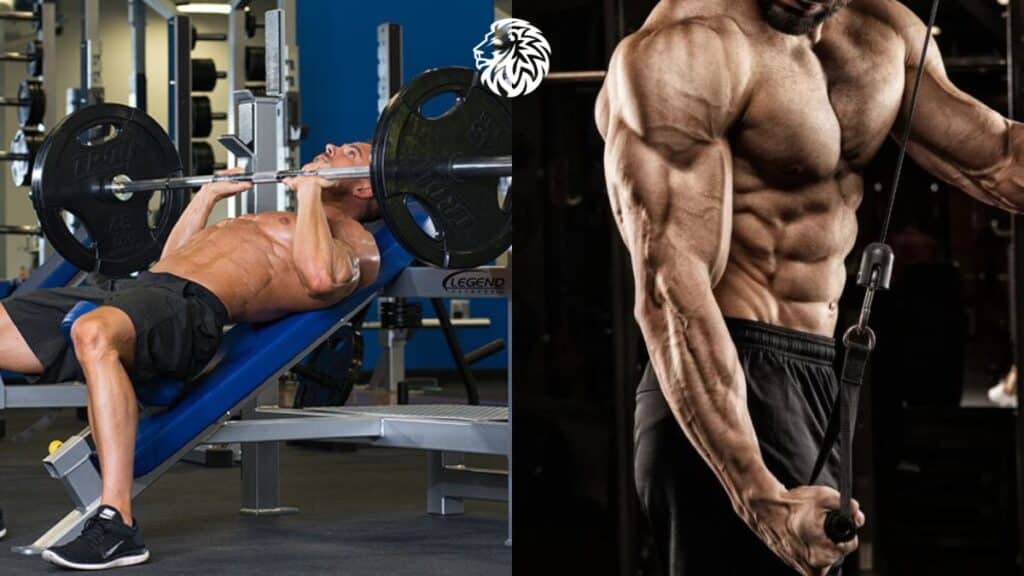
The benefits of superset workouts with chest and triceps exercises
Supersets, which involve performing two exercises back-to-back with little to no rest in between, are a great way to increase workout intensity and efficiency. Supersets with chest and triceps exercises can be particularly beneficial because while one muscle group is working, the other is resting, allowing for a quick and intense workout that effectively targets these muscle groups.
Example of a beginner’s workout routine
- Flat Bench Press: 3 sets x 12 reps
- Assisted Dips: 3 sets x 10 reps
- Incline Dumbbell Fly: 3 sets x 15 reps
- Push-ups: 3 sets x as many reps as possible
- Triceps Pushdowns: 3 sets x 15 reps
Example of an intermediate workout routine
- Incline Bench Press: 4 sets x 10 reps
- Dips: 3 sets x as many reps as possible
- Cable Chest Fly: 3 sets x 15 reps
- Close-Grip Bench Press: 3 sets x 10 reps
- Overhead Triceps Extension: 3 sets x 12 reps
Example of an advanced workout routine
- Decline Dumbbell Bench Press: 4 sets x 8 reps
- Weighted Dips: 4 sets x 10 reps
- Cable Chest Fly (low pulley setting): 4 sets x 15 reps
- Close-Grip Bench Press: 4 sets x 8 reps
- Overhead Triceps Extension: 4 sets x 10 reps
- Triceps Pushdowns: 4 sets x 15 reps
The importance of progressive overload in muscle building
Progressive overload is a key principle in muscle building. It involves gradually increasing the amount of stress placed on the body during exercise over time. This can be done by increasing the weight, increasing the number of repetitions or sets, or decreasing the rest time between sets. By continually challenging your muscles in this way, you stimulate growth and prevent plateaus in your muscle-building progress. Always ensure you’re maintaining proper form, even as you increase the intensity of your workouts.
Measuring Progress and Adjusting Your Routine
Importance of tracking progress
Tracking your progress is crucial for motivation and to ensure you’re moving towards your goals effectively. It helps you see your improvements over time, whether that’s lifting heavier weights, performing more reps, or noticing changes in your body composition. You can track your progress by keeping a workout journal, taking body measurements, taking progress photos, or using fitness apps.
How and when to adjust your routine for continued growth
As you become stronger and more fit, your body will adapt to your workout routine. To continue seeing results, you’ll need to adjust your routine by applying the principle of progressive overload. This might mean increasing the weight you’re lifting, performing more reps or sets, increasing the frequency of your workouts, or trying more challenging exercises. Generally, if you’ve been doing the same routine for 4-6 weeks and aren’t seeing progress, it may be time for a change.
Dealing with plateaus in muscle building
Hitting a plateau in muscle building is common. It’s when you stop seeing progress despite consistent workouts. When this happens, it’s important to review and adjust your workout routine and nutrition plan. You might need to increase your caloric intake, change your workout split, or add more intensity or volume to your workouts. Rest and recovery are also crucial – make sure you’re getting enough sleep and taking rest days to allow your muscles to repair and grow. Remember, progress can be slow at times, but consistency is key. If you’re feeling stuck, consider working with a fitness professional to help guide you through this period.
Common Mistakes and How to Avoid Them
Overtraining and lack of rest
One common mistake is overtraining, which can hinder progress and lead to injuries. This typically happens when you work out too intensely or too frequently without giving your body enough time to recover. To avoid this, ensure you’re taking rest days and getting plenty of sleep. Listen to your body – if you’re feeling excessively fatigued, sore, or notice a decrease in performance, it might be time to take a break.
Neglecting nutrition
Neglecting your nutrition can significantly impact your muscle-building efforts. If you’re not consuming enough protein, carbohydrates, and healthy fats, your body won’t have the necessary building blocks for muscle growth and recovery. Ensure you’re eating a balanced diet that supports your workout routine and muscle-building goals.
Poor form and injury prevention
Lifting weights with poor form is another common mistake that can lead to ineffective workouts and injuries. Always prioritize form over the amount of weight you’re lifting. If you’re new to strength training or trying a new exercise, consider working with a fitness professional to learn the correct form. Don’t rush through your reps – slow, controlled movements will lead to better muscle engagement and growth.
Conclusion
Developing a strong chest and triceps is beneficial for both functional movements in daily life and achieving a well-rounded aesthetic physique. The exercises and workout routines discussed provide an effective framework for targeting these muscle groups and promoting growth.
Muscle building is a journey that requires consistency, dedication, and patience. Remember, it’s not about instant results but gradual progress. Celebrate each small victory along the way, and don’t be too hard on yourself if progress seems slow at times. Your effort will pay off over time.
We’d love to hear about your experiences. What chest and triceps exercises have worked best for you? Have you tried the routines suggested? What tips do you have for others embarking on their muscle-building journey? Sharing our experiences and insights can help us all grow stronger together.







